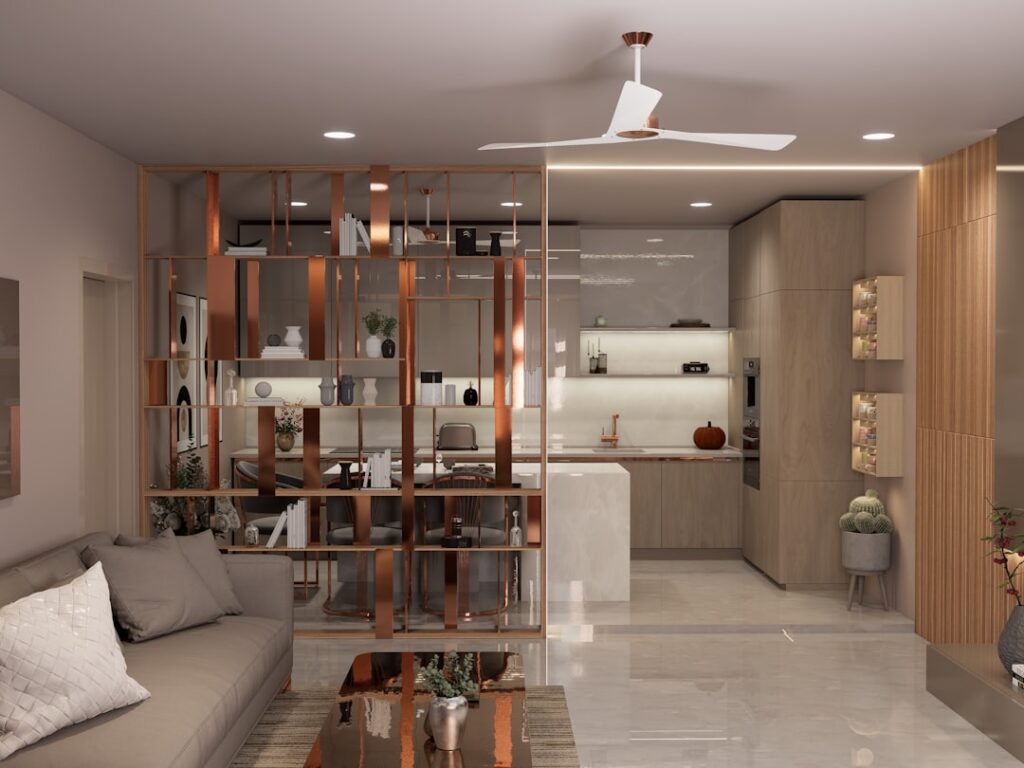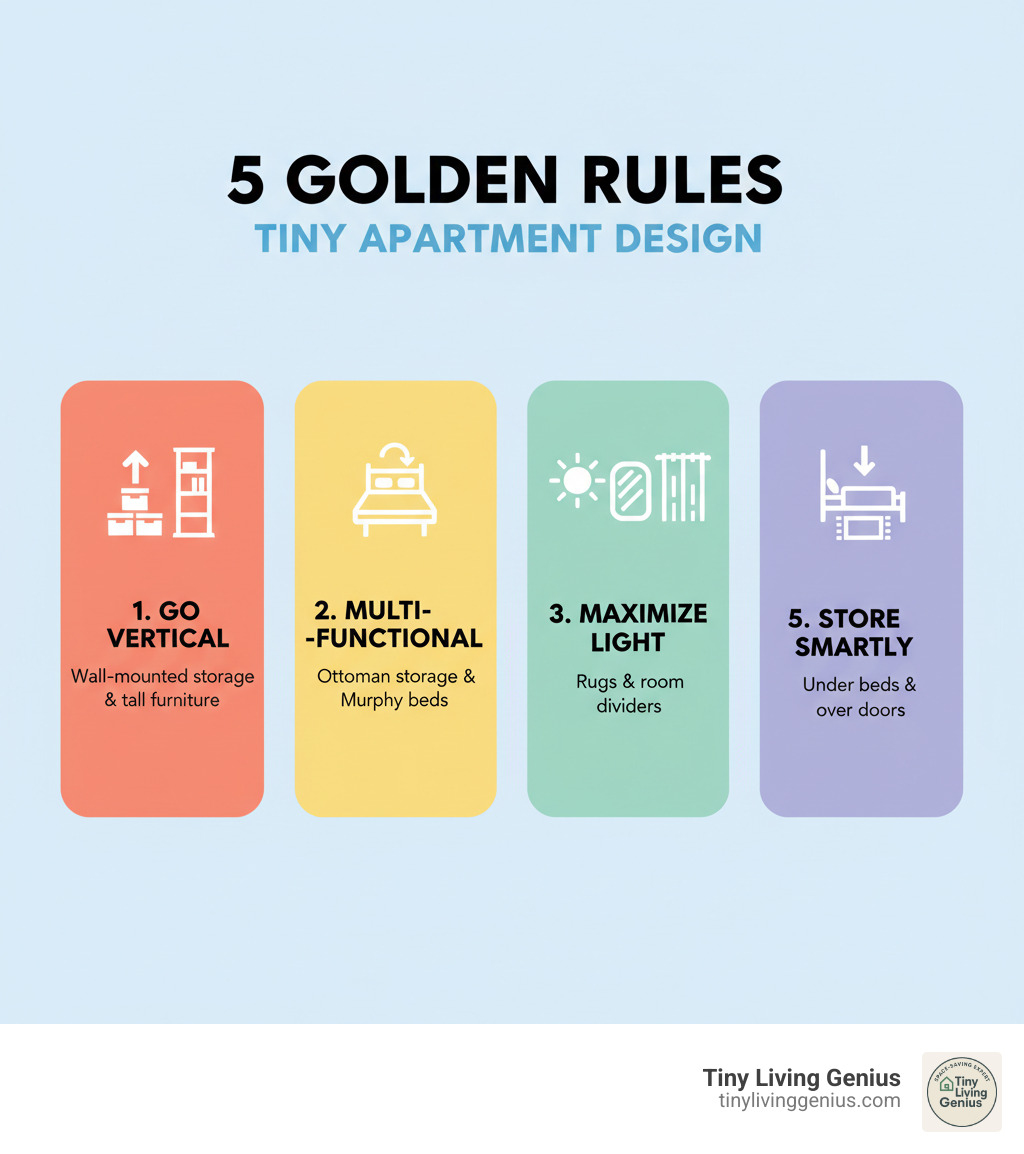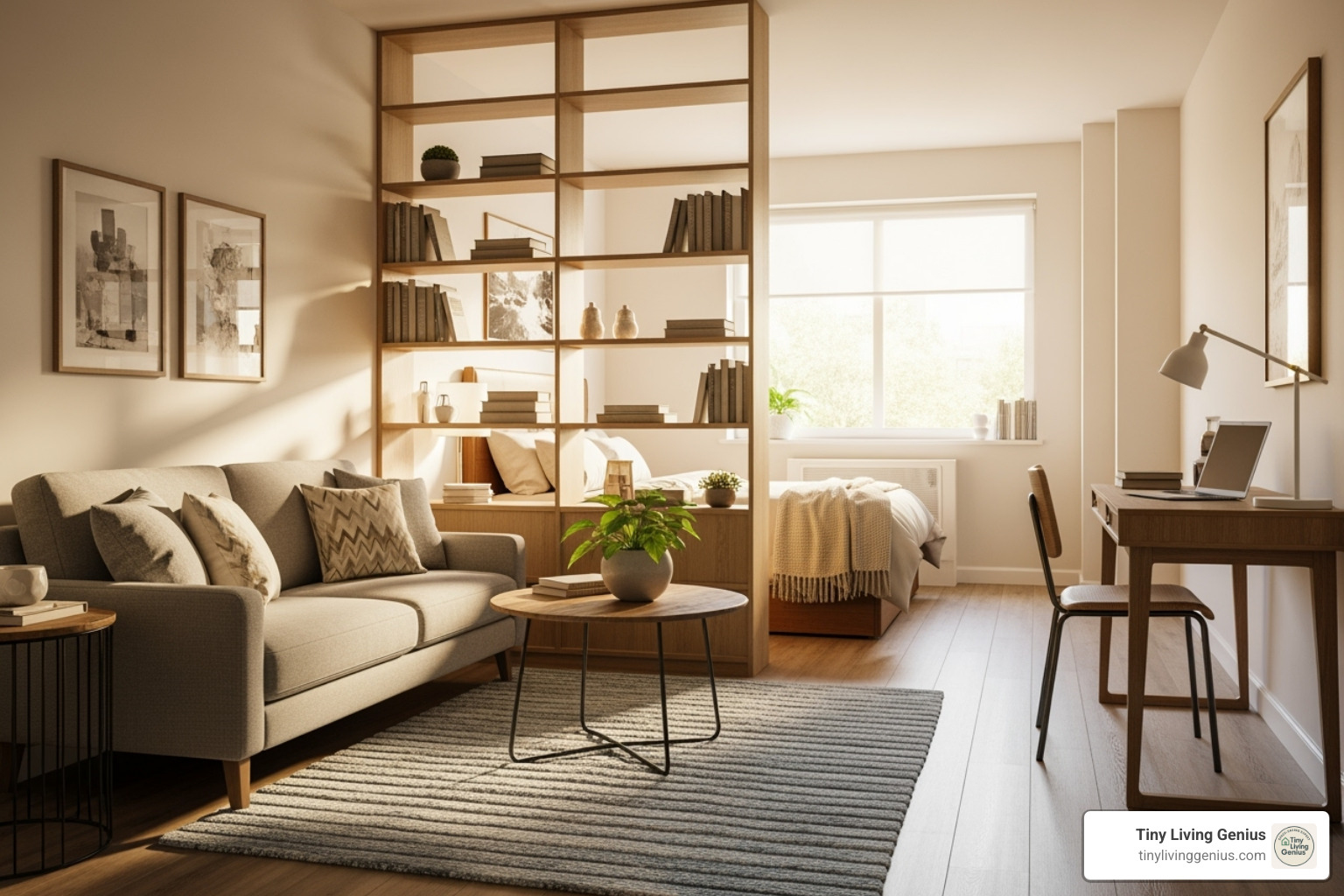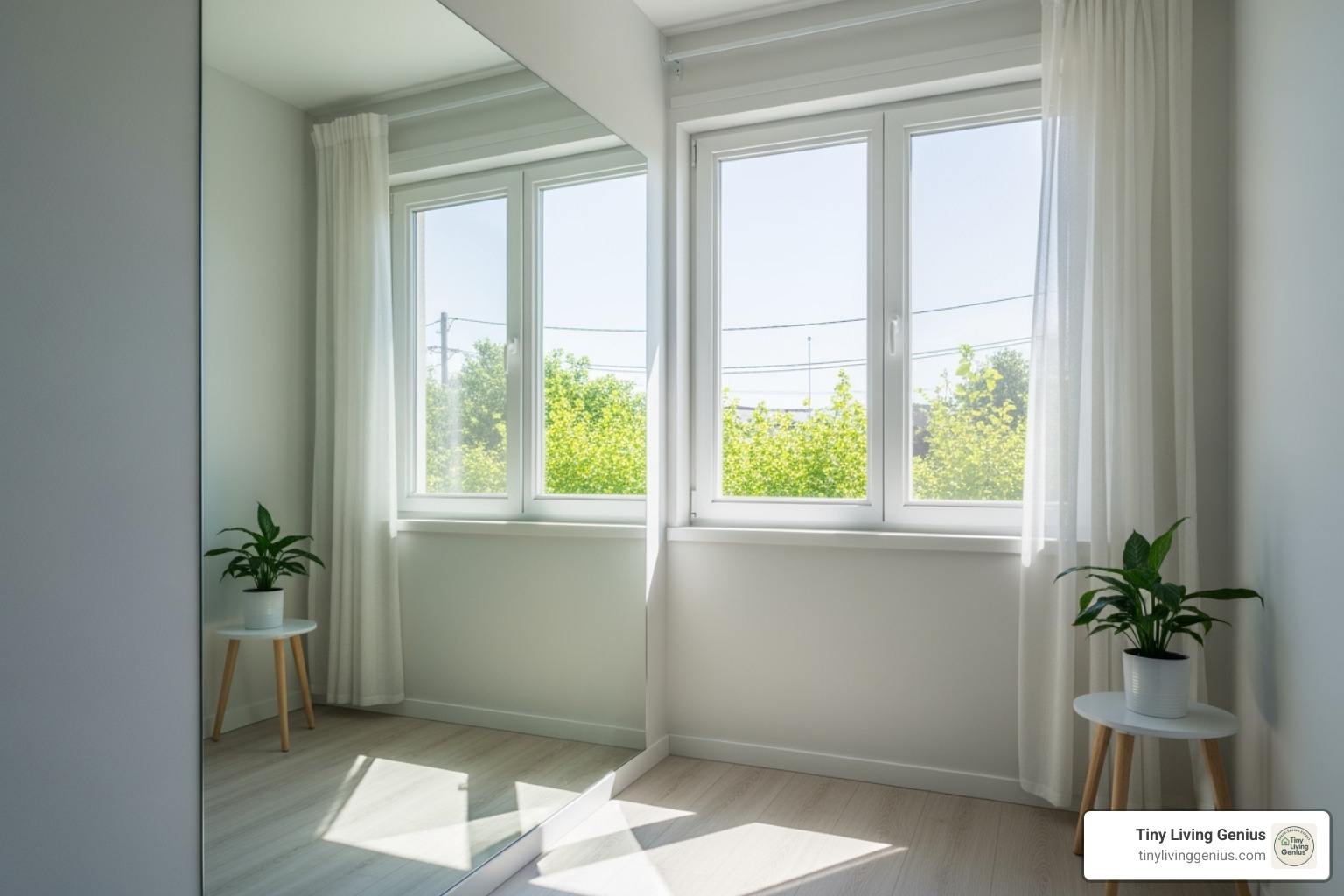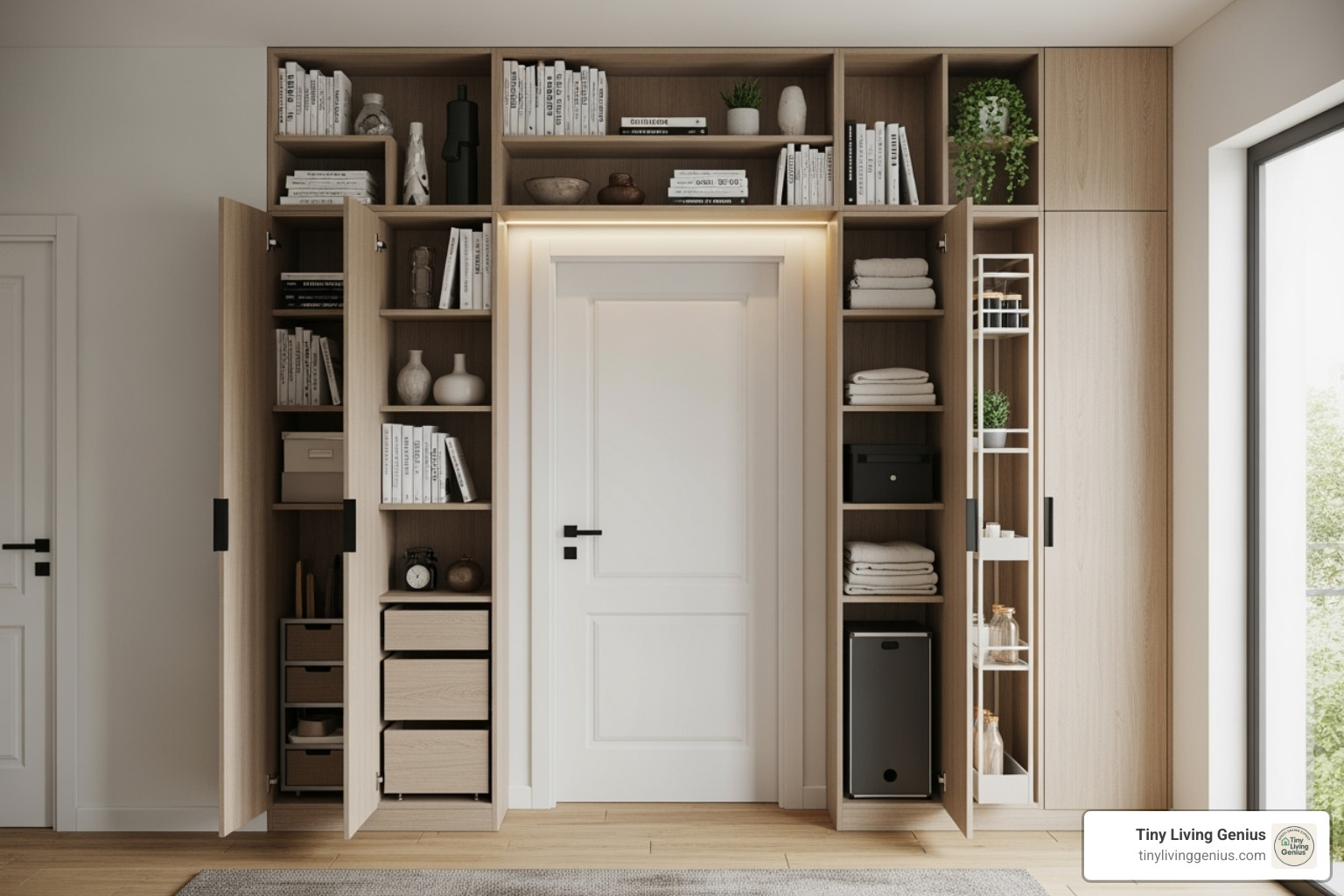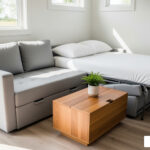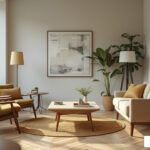Tiny apartment design: 5 Ingenious Hacks 2025
Why Tiny Apartment Design is the Key to Big Style in Small Spaces
Tiny apartment design transforms cramped quarters into stylish, functional homes through smart planning and creative solutions. Whether you’re dealing with a 200-square-foot studio or a micro-apartment, the right design strategies can make any space feel larger and more livable.
Essential Tiny Apartment Design Strategies:
- Go Vertical – Use wall space for storage and visual height
- Think Multi-Functional – Choose furniture that serves 2+ purposes
- Maximize Light – Use mirrors, light colors, and sheer curtains
- Create Zones – Define areas with rugs, furniture, or dividers
- Store Smartly – Find hidden storage in every nook and cranny
Living in a tiny space doesn’t mean sacrificing style or comfort. As one design expert notes: “Small apartments don’t have to be a challenge.” The secret lies in maximizing every square inch while creating distinct functional areas.
The statistics tell the story of our shrinking living spaces. Micro-apartments in Paris average just 86 square feet, while similar spaces in Sydney clock in at 258 square feet. These ultra-compact homes prove that with clever design, even the smallest footprint can feel spacious and welcoming.
The biggest challenges? Limited storage, awkward layouts, and the constant battle against clutter. But here’s the good news – every challenge has a creative solution.
I’m Ramy Saber, a Civil Engineer and founder of Tiny Living Genius with experience in project management and facility operations. My expertise in tiny apartment design comes from years of helping people maximize comfort and functionality in compact living spaces through practical, well-researched solutions.
Mastering the Layout: Strategic Furniture for Tiny Apartment Design
Let’s be honest – figuring out the layout for a tiny apartment can feel like solving a puzzle where half the pieces are missing! You’re dealing with weird corners, limited wall space, and somehow trying to fit your entire life into what feels like a shoebox. But here’s the thing: with smart tiny apartment design strategies, those challenges become opportunities for creative solutions.
The secret to making a tiny space work isn’t cramming everything against the walls or buying the smallest furniture you can find. Instead, it’s about being strategic with zoning strategies that create distinct areas without permanent walls. Think of your space like a theater stage – you’re the director deciding where each “scene” of your life takes place.
Room dividers become your best friend in this process. Open-backed bookshelves work like magic, giving you storage while separating your living area from your bedroom without blocking precious light. You can also try floating furniture in unexpected places – like positioning your bed with a dresser behind it to naturally create a bedroom zone.
Don’t underestimate the power of a simple area rug either. It’s amazing how an area rug can instantly define where your living room ends and your dining area begins, even in the tiniest studio.
When floor space is at a premium, it’s time to look up! Vertical space is like finding hidden square footage you never knew you had. Wall-mounted shelves and desks free up floor space while giving you all the storage and workspace you need. Some designers even create clever storage solutions by wrapping shelving over doorways – talk about using every inch!
Tall, slender furniture pieces are your friends here too. They draw your eye upward, making your ceiling feel higher and your room feel grander. For our guide on making the most of your walls and ceiling space, check out Maximize Vertical Space in Small Spaces.
Here’s something that might surprise you: furniture scale matters more than you think. Filling a tiny apartment with tiny furniture can actually make it feel like a dollhouse. Instead, choose pieces with visible legs that let light flow underneath, creating an airy feeling. See-through pieces like glass coffee tables or acrylic chairs provide function without visual weight.
The key is finding furniture that works with your space, not against it. For a deep dive into choosing pieces that actually make sense for small spaces, our comprehensive guide How to Choose the Right Furniture for Your Small Space: A Comprehensive Guide covers everything you need to know.
Embracing Multi-Functionality in Your Tiny Apartment Design
This is where tiny apartment design gets really exciting! Every piece of furniture should work overtime, serving at least two purposes. Think of it as getting more bang for your buck – and more function for your square footage.
Daybeds are perfect examples of this philosophy. During the day, they’re comfortable sofas for lounging and entertaining. At night, they transform into cozy beds. Ottomans with storage pull triple duty as seating, footrests, and hidden storage bins all rolled into one.
Expandable dining tables are game-changers too. A small console table can extend to seat six when friends come over, then shrink back down when you need the space. Some people skip traditional dining tables entirely, using counter stools that tuck completely under the counter.
Foldable furniture takes this concept even further. Wall-mounted desks that fold away when not in use instantly reclaim valuable floor space. One minute you have a home office, the next you have room for yoga or entertaining. We explore tons of these clever solutions in Creative Furniture Solutions for Small Spaces and 10 Foldable Furniture Ideas for Small Apartments.
Don’t forget about repurposed furniture either. A dresser can double as a nightstand, providing way more storage than a traditional bedside table. Even spare seating can serve as side tables when you’re not entertaining.
| Feature | Murphy Beds | Loft Beds | Platform Beds with Storage |
|---|---|---|---|
| Space Saving | Folds vertically into a wall or cabinet, freeing up entire floor space during the day. | Lifts the sleeping area, creating a large, usable zone underneath for work, living, or storage. | Built-in drawers or lift-up mechanisms offer discreet storage beneath the mattress. |
| Functionality | Converts a bedroom into a living area or office. | Creates distinct “rooms” within a single footprint. | Maximizes storage without needing extra furniture. |
| Ideal For | Studio apartments, guest rooms, multi-purpose rooms. | Very small apartments with high ceilings, maximizing verticality. | Any small bedroom needing extra storage without sacrificing floor space. |
| Pros | Excellent for reclaiming floor space; modern designs are sleek. | Creates significant additional functional space; often includes desks or seating. | Practical, integrated storage; no need for a separate dresser. |
| Cons | Can be expensive to install; requires wall mounting; less spontaneous napping. | Requires climbing; may not be suitable for all ages; needs high ceilings. | Storage access can be less convenient than a dresser; may look bulky. |
The beauty of multi-functional furniture is that it doesn’t just save space – it simplifies your life. When everything has a purpose (or two or three), your tiny apartment becomes a well-oiled machine where every square inch works hard for you.
The Art of Illusion: Using Light, Color, and Materials
Here’s where tiny apartment design gets really exciting – we’re about to become magicians! The secret to making your small space feel twice its size lies in mastering the art of visual tricks. With the right combination of light, color, and materials, you can transform even the tiniest apartment into a bright, airy haven that feels surprisingly spacious.
Maximizing Natural Light
Natural light is absolutely magical in small spaces. It’s like having a free renovation that happens every morning when the sun rises! The more natural light you can capture and spread throughout your apartment, the more open and inviting it will feel.
Mirror placement is your best friend here. Position a large mirror directly across from your biggest window, and watch the magic happen. The mirror will catch all that beautiful daylight and bounce it back into your room, essentially doubling your light source. It’s like having two windows instead of one!
Sheer curtains are another game-changer. Heavy, dark drapes might give you privacy, but they’re also stealing precious light from your space. Swap them for light, flowing sheers that let sunshine filter through while still giving you the privacy you need. Your room will instantly feel brighter and more connected to the outdoors.
Don’t forget to keep your windows clear of clutter. That windowsill might seem like prime real estate for storage, but every item you place there is blocking light from entering your home. Let those rays pour in unobstructed – your space will thank you for it.
Color Psychology: Painting Your Way to More Space
Color is one of the most powerful tools in your tiny apartment design toolkit. The right colors can literally trick your brain into thinking a space is larger than it actually is.
White walls aren’t boring – they’re brilliant! White and other light colors act like mirrors for natural light, bouncing it around your room and making everything feel more open and airy. If pure white feels too stark, try soft grays, warm creams, or gentle pastels for a similar effect with more personality.
Monochromatic color schemes work wonders in small spaces. When you use different shades of the same color throughout your apartment, you create a seamless flow that makes the eye travel smoothly from room to room. This visual continuity tricks your brain into perceiving the space as larger and more cohesive.
Sometimes, a well-placed accent wall can actually add depth to your space. Choose one wall to paint in a slightly deeper shade or a complementary color. This creates visual interest and can make your room feel like it has more dimension. Just remember – less is more in tiny spaces, so stick to one accent wall maximum.
Here’s a fun trick: try painting vertical stripes on one wall. Thin stripes (no wider than 1.5 inches) can make your ceilings appear taller, giving your entire space a more spacious feel. It’s like giving your apartment a visual growth spurt!
Material Choices: Reflective and Light-Enhancing
The materials you choose for your furniture and decor can either help or hinder your space-expanding goals. Smart material choices can make your tiny apartment feel bright, open, and surprisingly roomy.
Reflective surfaces are your secret weapon. Beyond mirrors, think about incorporating glossy finishes on furniture, shiny metal accents, or even a mirrored backsplash in your kitchen. These surfaces catch and reflect light throughout your space, creating a brighter, more dynamic environment.
Glass and metal elements are perfect for small spaces because they’re visually lightweight. A glass coffee table or metal shelving unit provides all the function you need without the visual bulk of solid wood pieces. Your eye can see right through them, which helps maintain that open, airy feeling.
When you do choose wood elements, opt for light-colored varieties like birch, ash, or light oak. These lighter woods contribute to that bright, spacious aesthetic you’re after, while darker woods can make a small space feel cramped and cave-like.
The beauty of these design tricks is that they work together. Combine a light color palette with reflective surfaces and smart lighting, and you’ll be amazed at how much larger your tiny apartment can feel. It’s not about the square footage you have – it’s about how cleverly you use what you’ve got!
Smart Storage and Renter-Friendly Personalization
Storage is the eternal puzzle of tiny apartment design. Where do we put our winter coats when our closet is the size of a phone booth? How do we display our favorite books without turning our living room into a library maze? The good news is that every tiny space has hidden storage potential – we just need to know where to look.
The space under your bed is pure gold for storage. Platform beds with built-in drawers transform this dead zone into a treasure chest for seasonal clothes, extra linens, or those bulk paper towel purchases. Even a simple raised bed with rolling bins underneath can double your storage capacity overnight.
Over-the-door organizers are the unsung heroes of small space living. The back of every door is valuable real estate waiting to be claimed. Shoe organizers, cleaning supply caddies, or toiletry holders can free up precious cabinet space that’s better used for everyday items.
Don’t overlook your windowsills – they’re not just plant platforms! These built-in shelves are perfect for displaying books, small decorative pieces, or even spice jars if your kitchen window gets good light. It’s like having extra counter space that doesn’t take up any floor room.
Hidden storage is where furniture earns its keep in tiny spaces. Ottomans that lift to reveal storage compartments, coffee tables with secret drawers, and benches with built-in cubbies all pull double duty. Every piece of furniture should work harder than a single-function item in a small space.
The real magic happens when we start utilizing awkward spaces that most people ignore. Sarah Tract’s team maximized every corner of a NYC apartment by thinking creatively about unused areas. Corner shelving units transform dead space into functional displays, while shallow built-ins can blend seamlessly into walls.
Top-shelf storage is brilliant for items you don’t need daily. Melanie Millner’s cubby-like bookcase built-ins wrapped over a doorway show how vertical space above eye level can store seasonal items without eating into your living area.
For comprehensive storage inspiration, explore our guide on Smart Storage Solutions for Small Spaces.
Creative Storage Solutions for Your Tiny Apartment Design
The best storage solutions are the ones no one sees coming. Behind kick plates in your kitchen or bathroom, you can install shallow pull-out drawers perfect for cookie sheets, cleaning cloths, or pet supplies. It’s storage hiding in plain sight.
Hollow furniture bases offer sneaky storage opportunities. A sturdy coffee table with a hollow base can house remote controls, chargers, or small games. Some furniture makers even create custom pieces with these hidden compartments built right in.
If you own your apartment, wall cavities between studs can become recessed shelving for spices, toiletries, or books. This built-in storage adds function without taking up any depth in your room.
Above interior doors is prime real estate that most people never consider. A shallow shelf installed above a door frame creates a perfect spot for decorative items or rarely-used belongings. It’s storage that floats above your everyday life.
Under stairs in multi-level tiny apartments can house pull-out drawers, a mini-pantry, or even a compact workspace. This classic storage spot is often overlooked but offers surprising capacity.
Our collection of 10 Best Space-Saving Beds with Storage for Small Apartments showcases how your sleeping area can become a storage powerhouse.
Renting doesn’t mean you have to live in a personality-free box. The key is making changes that wow without costing you your security deposit. Removable wallpaper has revolutionized renter decorating – you can transform an accent wall, add texture, or even create a statement ceiling that peels off cleanly when you move.
Adhesive hooks and strips are your damage-free hanging solution. Command strips let you display artwork, mirrors, and lightweight shelving without a single nail hole. Leaning oversized art against walls creates gallery-worthy displays that require zero wall damage.
Statement textiles instantly transform any space. Throws, pillows, rugs, and curtains can completely change your room’s mood and color palette. They’re like a wardrobe change for your apartment – swap them seasonally or whenever you need a refresh.
Plants bring life and personality to tiny spaces. Hanging plants save surface space while adding vertical interest, and small potted plants on shelves create natural focal points that make your space feel fresh and intentional.
Creative lighting sets the mood without permanent installation. Floor lamps, table lamps, and plug-in sconces create ambiance while saving precious floor space. Wall-mounted lighting eliminates the need for side tables in tight quarters.
The beauty of renter-friendly personalization is that you can experiment freely. Try bold wallpaper in your bathroom, create a gallery wall with removable strips, or transform your space with colorful textiles. When it’s time to move, everything comes with you – and your deposit stays put.
Frequently Asked Questions about Tiny Apartment Living
Living in a tiny space brings up plenty of questions, and after years of helping people transform their compact homes, I’ve heard them all! Let me share the answers to the most common concerns about tiny apartment design that come my way.
What is the best furniture for a tiny apartment?
The secret to great furniture in small spaces? Think like a multitasker! Every piece should earn its place by doing at least two jobs well.
Multi-functional pieces are your best friends. A daybed works as comfortable seating during the day and transforms into a cozy bed at night. Ottoman storage cubes can serve as extra seating, footrests, coffee tables, and hidden storage all at once. It’s like having a Swiss Army knife for your living room!
Foldable furniture is another game-changer. Wall-mounted desks that fold away when you’re done working instantly give you back precious floor space. Expandable dining tables can host dinner parties or shrink down to console size for everyday living.
Don’t fall into the “tiny furniture for tiny spaces” trap though. Scaled-down items should fit your room’s proportions without making it feel like a dollhouse. An armless sofa, for example, gives you a sleek look in tight corners without overwhelming the space.
Look for furniture with visible legs and reflective elements too. Pieces that let light flow underneath or have chrome legs and glass tops create an airy feeling that makes your room breathe easier.
Vertical storage units are essential – think tall, narrow bookshelves that stretch to the ceiling. They maximize storage without gobbling up floor space, which is pure gold in a tiny apartment.
How can I make my tiny apartment look bigger without renovating?
You’d be amazed at what a few smart tricks can do! No sledgehammer required.
Light paint colors work magic. White walls, soft grays, and gentle pastels reflect light beautifully, making your space feel brighter and more open. It’s like adding windows without the construction work.
Large mirrors are your secret weapon. Place one opposite a window, and you’ll double your natural light while creating the illusion of depth. It’s an old designer trick that never fails.
Sheer curtains instead of heavy drapes keep that airy feeling alive. You get privacy without blocking precious natural light – the best of both worlds.
Here’s the tough love part: declutter ruthlessly. A cluttered space always feels cramped, no matter how big it actually is. Keep surfaces clear and accept a more minimalist approach. Every item should have a purpose and a place.
A monochromatic color scheme creates visual flow without interruption. When everything works together in similar tones, your eye travels smoothly through the space instead of getting caught on jarring color changes.
Don’t forget to maximize vertical space with floor-to-ceiling curtains or tall shelving. Drawing the eye upward makes ceilings feel higher and rooms feel grander.
How do you divide a room in a tiny apartment?
Creating distinct zones in a studio or small apartment is like solving a fun puzzle – and there are several clever solutions that don’t require permanent walls.
Open-backed bookshelves are fantastic room dividers. They create visual separation while letting light flow through, plus you get bonus storage and display space. It’s like having your cake and eating it too.
Ceiling-mounted curtains offer incredible flexibility. Draw them closed for privacy in your sleeping area, or pull them back to open up the entire space. They’re perfect for renters who can’t make permanent changes.
Area rugs work surprisingly well as invisible room dividers. A large rug under your living area and a different one in your sleeping zone creates clear boundaries without blocking light or views.
Folding screens give you the ultimate flexibility. Move them around as needed, or tuck them away completely when you want an open floor plan. Look for lightweight, semi-transparent options that won’t make your space feel closed off.
Sometimes floating furniture does the trick beautifully. A sofa placed with its back toward your sleeping area creates a subtle but effective division between your living and bedroom zones.
The key is choosing solutions that work with your lifestyle and can adapt as your needs change. After all, flexibility is one of the greatest advantages of small space living!
Conclusion
Living in a tiny space doesn’t mean living small. Throughout this guide, we’ve finded that tiny apartment design is really about making smart choices that work harder for you. Every strategy we’ve explored – from multi-functional furniture to clever storage solutions – proves that small spaces can be both stylish and incredibly functional.
The beauty of tiny living lies in its creativity. When we accept verticality by using wall-mounted shelves and lofted beds, we literally double our usable space. When we choose multi-functional pieces like daybeds and expandable tables, each item earns its place by serving multiple purposes. And when we use visual tricks with light colors, mirrors, and reflective materials, we create the illusion of spaciousness that makes our homes feel twice their actual size.
Remember those challenging micro-apartments we discussed? The 86-square-foot Parisian studio and the 258-square-foot Sydney apartment show us what’s possible when we think outside the box. These spaces aren’t cramped – they’re curated. They’re not limiting – they’re liberating.
Your tiny apartment has enormous potential waiting to be open uped. Whether you’re dealing with awkward layouts, storage challenges, or rental restrictions, there’s always a creative solution that can transform your space into something truly special.
The secret isn’t having more space – it’s using the space you have more intelligently. At Tiny Living Genius, we believe that thoughtful design can turn any compact home into your perfect sanctuary.
Ready to transform your tiny space into something amazing? Explore our complete guide to space-saving furniture and find the pieces that will make your small apartment work beautifully for your lifestyle.

